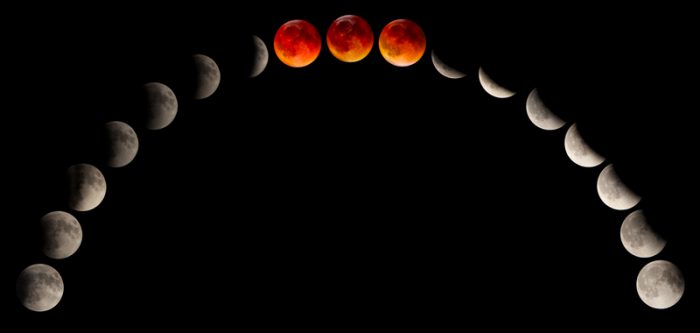On July 27, there will be a total lunar eclipse. This happens when the Earth passes in between the Moon and the Sun and completely blocks direct sunlight from hitting the Moon. By blocking off the Sun's rays, the Moon goes dark ... or rather, deep red.
Known as a Blood Moon, this happens because the only rays that are able to bend around Earth and still hit the Moon come from the red part of the spectrum. Sunsets appear red for a similar reason. Any time an eclipse/Blood Moon occurs is a reason to pay attention. It's a pretty rare thing. And it's quite beautiful, too!
Generally, these happen around twice every two years. This year, we've been lucky—a total lunar eclipse already happened on January 31 this year, and it was a special one.
Well, the one coming up this Friday evening will also be a rare occurrence. And for us here in North America, it comes with good and bad news attached. Which would you like first?
Lucky you, St. John's
Let's start with the bad. This total lunar eclipse is not visible at all in North America. Bummer! St. John's and parts of eastern Newfoundland will get a small taste of what's called the partial phase. They'll see the Earth's shadow pass across the Moon, but from their angle, they won't see the total eclipse—the moment when our planet completely covers it. Better than nothing!
Now time for the good news. For those living in eastern and southern Africa, the Middle East, India and other parts of central Asia, they will view get a complete view of what should be the longest-lasting lunar eclipse this century. Just how long? 6 hours and 14 minutes, with the total phase lasting an incredible 1 hour and 43 minutes. That's almost a full half hour longer than the total eclipse this past January 31!
Long distance call
A lot of things need to line up perfectly to get a total lunar eclipse. Literally! But what will make this eclipse extremely rare are the relative positions of the Earth, Moon, and Sun. Not only will they line up, they will also be at a maximum distance from one another.
You see, the orbits of the planets and their moons aren't perfectly symmetrical. For example, in early January, Earth is at its closest position to the Sun, or perihelion—147.1 million km (91.4 million mi.). But in early July, it reaches its furthest point from the Sun, or aphelion—152.1 million km (94.5 million mi.). So on July 27, the Earth will be almost as far from the Sun as it can get.
In addition, the Moon will basically be at the furthest point from Earth. How does all of this make an eclipse longer?
Place your hand in front of a light source right now. See its shadow on the wall. Move your hand closer to the wall. Now pull it back. The further your hand is from the wall, the bigger the shadow gets. That's what is going to happen with this eclipse—the Earth will cast a bigger shadow on the Moon, meaning it will take longer for it to cross through it. Neat!
Sure, it's a shame that North America can't view it for real, but there is a live stream available for those of you who want a peek of this awesome lunar event. Enjoy!
 If you're in the right place on Earth, this next total lunar eclipse is going to hang around for a long time. (© Le Thuy Do | Dreamstime.com)
If you're in the right place on Earth, this next total lunar eclipse is going to hang around for a long time. (© Le Thuy Do | Dreamstime.com)









